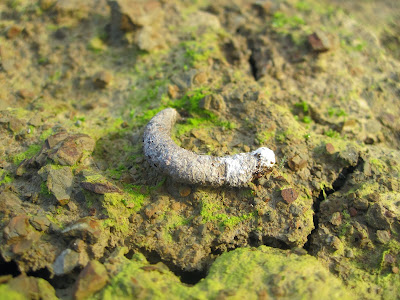Veteran oak tree, Land East of the Railway Line
It feels like we have packed an incredible amount into December. Winter provides us with only a short window for cracking on with habitat management and it is a race to complete these jobs before the spring wildlife starts waking up again. With the incredible amount of wet weather resulting in Gatwick's rivers and streams flooding out, this will be no mean task
Earlier this month, conservation work started with JS Agriculture and Gatwick Greenspace Partnership working together in the North West Zone. We coppiced the willows and scrub on a grassy slope which was becoming over shaded.
Coppicing willows on the grassy slope
Gatwick's ranger Tom S then improvised by staking the cut wood into habitat piles half-way up the slope, providing cover for wee beasties but leaving the wet grassland clear of debris at the bottom.
Scott finishing up our hibernacula in the Scrub West of Brockley Wood
More recently, Scott T did a grand job of moving some logs and tree stumps onto the new hibernacula in Scrub West of Brockley Wood. Sometimes I wish I could be trained to use a digger, but then with great power comes great responsibility and I can get a little power hungry.
Another completed hibernaculum - not pretty but perfect for invertebrates, reptiles and other wildlife
Our regular group of British Airways Engineers (BAE) definitely have a pact with the weatherman; on a revoltingly sunny day in mid-December, they were led by Gatwick Greenspace Partnership (GGP) on a woodland conservation task. They bridged the ditch on the main path into Brockley Wood, improving access for future work, also removing the old barbed wire, plastic tree guards and some litter. Because they can smash out these jobs in record time, I barely got any photo opportunities...
BAE installing a footbridge, East of Brockley Wood
Railway sleeper footbridge
BAE and Gatwick Greenspace Partnership
Well-hidden: a ball of woven grass hidden in a large tussock
A rather large Harvest Mouse nest constructed of Cock's Foot grass.
It was probably used as a breeding nest earlier this year
While carrying out these searches, we were lucky enough to be serenaded by a very loud Water Rail. This wading bird turned up in our winter bird survey last year but eluded us on our most recent one. It still counts though as an individual record and will be added to Gatwick's species database. I think they sound a bit like excitable piglets.
We completed our final early winter bird survey this month in the Land East of the Railway Line. The pace has really picked up with thrushes - mixed flocks of Fieldfare, Redwing, Song Thrush, Mistle Thrush and Blackbird are abound, testing our identification skills.
Recording on our Winter Bird survey
Goat Meadow's mug-holder tree. Sadly no coffee was left in them... Mean dog walkers.
Tom F in the scrub, deep in conversation with a flock of Redwing
Looking ahead to January and February, there is an incredible amount to do and we are going to need all the volunteer help we can get. My to do list will probably keep on growing, but I seem to be running out of whiteboard...
*gulp*
Tom S is planning some conservation taster days in the New Year, so if you want to find out whether all this 'getting-back-to-nature' stuff is overrated, drop Tom a line at thomassimpson@sussexwt.org.uk or learn more here about Gatwick Greenspace Partnership and their work.
River Mole culvert, North West Zone after recent heavy rains
A massive, massive thank you to all who have been involved this past year, you have helped make this a brilliant project to work on. We hope to see you again in 2014!











































